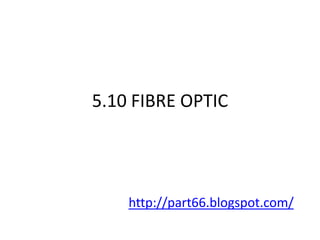
EASA Part 66 Module 5.10 : Fibre Optic
- 2. WHAT IS FIBRE OPTIC • Flexible, transparent fiber made of a pure glass (silica). • It functions as light pipe, to transmit light between the two ends of the fiber. • It is an opto-electronic component (sensitive to infrared, ultra violet that convert to electrical signal) • Use in medical, telecomunication and aviation field.
- 4. ADVANTAGE • Larger data carry – up to 3300MHz • Low loss of signal • Smaller diameter, lighter-weight cables • Cross talk negligible – no effect to other cable(signal) • Immunity to electromagnet interference • Greater security – immune to wiretapping • Greater safety – free from spark • Low cost – material sand • Long life span – double from conventional cable • Greater reliability – resistance to corrotion and temp
- 5. DISADVANTAGE • Installation cost high • Fragile than wire • Required special equipment for testing • Required special skill and equipment to splicing it
- 6. OPERATION Receiver Transmitter Optical Coupling (Light (Light Source) Detector) Transmitters: Light-emitting diodes (LED's) and Injected Lasers Convert electrical signal to optical signal. To send the optical signal over an optical fibre Receivers: Photodiodes and Phototransistors. To convert optical signal back to an electrical signal Optical Coupling: Opto-isolators and Optical fibres
- 7. LIGHT • Light wave more shorter than electromagnetic wave (radio/radar). • Velocity 3x108m/s, change depend on medium. • Propogation of light : – Reflection – Refraction – Dispersion
- 8. REFLECTION The light reflect back with same angle if surface is smooth The light diffuse reflection if surface is irregular/rough
- 9. REFRACTION Bending of light when passes through other medium Air 1 00 Diamond 2 42 Ethyl Alcohol 1 36 Fused Quartz 1 46 Glass 1 55 - 1 9 Optical Fibre 15 Water 1 33 Index of refraction
- 10. DISPERSION • Seperation of white light to the various color. • Different color have a different wavelength, different velocity and different index of refraction.
- 11. CABLE STRUCTURE High strength and tension resistance Typically cable made in length of 1-3 km without splices. Core - glass, polystyrene, polymethylmethacrylic. Cladding - glass, silicon or Teflon.
- 12. TYPE OF CABLE Wide graded index multimode optical fibre Single mode step index optical fibre Large-core plastic-clad silica optical fibre
- 13. HOW IT WORK Single Mode Multimode
- 14. ACCEPTANCE ZONE
- 15. NUMERICAL APERTURE • Its a colecting power of an optical fibre • Its value from 0 to 1, • Larger NA mean the greater amount light accepted by fibre. • NA is function of refractive index of the fibre. • Define as NA = sin A
- 16. PULSE SPREADING • The amount of acceptance signal have a limited frequency due to the pulse(light) is being dispers inside the cable. • Dispersion tend to slow down the speed of the light. • Two form of dispersion : – Chromatic disepersion : Different speed due to color – Modal dispersion : Zigzag ray reach the end of cable later than straight ray • Total Dispersion = Chromatic + Modal
- 17. CONSEQUENCES • The fastest the pulse travel, the worse spreading its get. • Need to limit the frequency of the signal travel
- 18. ATTENUATION • Reduction of signal strength due to : 1. Atomic Absorption : Atom of material absorb some of the light 2. Scatering by Flaw and Impurities : Depend on size of scatering particle inside the cable 3. Reflection by Splices and Conector : Some light are reflected back even for perfect splice or conector.
- 19. JOINING OPTICAL FIBRE – Fusion Splicing • Allign manually using micromanipulators and microscope system. • End of fibre are melt together using electric arc. • Near perfect splice can lose as low 0.2dB – Mechanical Splicing • Two fibre end held together in splice equipment which automatically allign the two fibre. • Clamp it and expose to ultra-violet light to cures the cement
- 20. SPLICING ERROR • The end of fibre must be precisely line each other to enable light pass from one fibre to another. • Typicall allignment error :
- 21. FIBRE OPTIC CONNECTOR 2 Type Conector A and B, both have : - Allignment key and grooves - Guide pin and cavities - Color bands - Three start threads A type : - 3 or 5 optical fibre - Multichannel - very low loss B type : - For LRU - Multichannel - For more frequent conection and disconection
- 22. FIBRE OPTIC IN AIRCRAFT • Advantage on aircraft : – Can carry more data – Less weight – Immune to electromagnetic radiation • Purpose: – Network system: (OLAN),(AVLAN),(CABLAN)
- 23. AIRCRAFT NETWORK SYSTEM • Flight attendent – Keep sales data – Enable and disable passenger functions – Control the distribution of video entertainment – Select boarding music • Passenger – Video and menu screen – Games – Inflight sales catalogue – Instruction for telephone call – Ground to airplane telephone pages – Special video channel selection
- 24. ONBOARD LAN
- 25. CABIN LAN